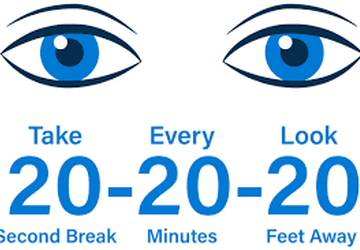7 Tips for Reducing Eye Strain When Using Computers and Mobile Devices
How many times have you blinked rapidly after a long stint on your computer? Do your eyes feel tired, itchy, or even sore after using your mobile device for hours?
Prolonged exposure to screens can lead to eye strain, which, if not addressed, could lead to more serious eye problems in the future.
We live in a digital age, where screens dominate most of our daily tasks. As a matter of fact, how often do you really give thought to the toll these screens might be taking on your eyes?
While the wonders of technology enrich our lives, they also present challenges we might not always acknowledge.
Imagine a future where the simple joys of reading a book, admiring nature, or recognizing a friend's face from a distance become strenuous tasks.
A bit alarming, isn't it? But worry not; it doesn’t have to come to that. With awareness and timely action, we can counteract these challenges.
Don't worry , we’re here to help you, read this blog post. Our experts tell you how to reduce eye strain when using computers and mobile devices.
Tips for Healthy Screen Time
Screens have revolutionized our lives, making communication, work, and entertainment incredibly accessible. From attending virtual meetings and binge-watching our favorite shows, they've become indispensable.
However, while they offer numerous benefits, it's crucial to manage our screen time to avoid eye strain. Just as we value the advantages screens provide, we must also prioritize our eye health for sustained comfort and clarity. It's all about balance and care.
1. Follow the 20-20-20 Rule

One of the most effective and straightforward ways to reduce eye strain is the 20-20-20 rule. It's a simple yet powerful habit to inculcate. Every 20 minutes, take a break and look at something 20 feet away for at least 20 seconds.
This short pause allows your eyes to refocus and reduces the strain caused by staring at a screen for prolonged periods. The beauty of this tip lies in its simplicity and effectiveness.
Important Aspects:
● Consistency is key. Make it a habit, set reminders if needed.
● Use this break to stretch your body too, benefiting your overall posture.
● Combine this with proper screen brightness and contrast for best results.
Adopting the 20-20-20 rule can make a significant difference in reducing eye strain. Not only is it easy to implement, but it's also a game-changer for your overall eye health.
2. Adjust Screen Brightness and Contrast
The glare from overly bright screens is a primary culprit behind eye strain. Adjusting screen settings can make a world of difference. Ensure your screen brightness is in sync with the room's lighting.
Ideally, the screen should not be a light source. Adjust the contrast to a comfortable level, ensuring text is clear without being excessively sharp.
Important Aspects:
● Consider using apps or software that adjust screen color temperature based on the time of day.
● Matte screen protectors can help reduce glare.
● Regularly clean your screen to avoid smudges that can cause additional strain.
With a few tweaks in your screen settings, you can create an optimal visual experience. Say goodbye to unnecessary eye strain by customizing your screen to suit your comfort.
3. Ergonomic Workspace and Regular Blinking
Position your screen slightly below eye level and about an arm's length away. This angle is more natural for the eyes. Additionally, remind yourself to blink regularly. Blinking moistens the eyes, preventing dryness and irritation.
A comfortable setup combined with regular blinking ensures your eyes remain refreshed, reducing the chances of strain and discomfort.
Important Aspects:
● Invest in a good quality chair with proper lumbar support.
● Use anti-reflective lenses if you wear glasses.
● Stay hydrated; it aids in maintaining eye moisture.
An ergonomic workspace combined with the simple act of regular blinking can be revolutionary. Prioritize your comfort, and your eyes will thank you for it.
4. Blue Light Filters: An Eye-Saver
Blue light emitted from screens can significantly contribute to eye strain. Thankfully, there's a solution: blue light filters. Use built-in settings or third-party apps to activate a blue light filter, especially during the evening.
Blue light affects the circadian rhythm and can make it harder to fall asleep. By reducing it, you not only prevent eye strain but also improve your sleep quality.
Important Aspects:
● Several devices come with a 'Night Mode' or 'Reading Mode' – use them.
● For computers, consider applications like 'f.lux' to auto-adjust screen warmth.
● Blue light blocking glasses are also available for those who spend extended hours in front of screens.
Adapting to a world with less blue light can drastically reduce your chances of experiencing eye discomfort. Make use of the technology available and prioritize your eye's comfort.

Distance matters! Keeping your screen too close can make your eyes work harder, leading to strain. The screen should be at an arm's length away. If you find yourself leaning closer, increase the font size or zoom in.
By maintaining a proper distance, you're giving your eyes a more comfortable focus point, reducing the need for constant refocusing, which often leads to strain.
Important Aspects:
● If using a mobile device, resist the urge to bring it closer to your face.
● Adjust your device's font size for a more comfortable reading experience.
● Regularly check your posture; slouching can bring you closer to the screen.
Maintaining the right distance from your screen is a simple yet effective way to reduce the strain. Combine it with the other tips, and you're on your way to a much more comfortable screen experience.
6. Stay Hydrated and Use Eye Drops
Hydration isn't just for your body; your eyes benefit too! Drink plenty of water throughout the day. If you experience dry eyes, consider using lubricating eye drops (after consulting with an eye specialist).
Hydration ensures that your eyes remain moist. Dry eyes can lead to irritation, making screen time uncomfortable.
Important Aspects:
● Remember the 8x8 rule: 8 glasses of 8 ounces of water daily.
● Ensure the room has adequate humidity, especially in drier climates or seasons.
● Avoid direct air from fans or ACs hitting your eyes.
Hydration is a game-changer for eye comfort. With adequately moist eyes, you're less likely to experience strain or discomfort during screen time.
Regular check-ups aren't just for your teeth or general health; your eyes need them too. Schedule regular eye exams with an optometrist. They can provide tailored advice, prescribe corrective lenses if needed, and detect potential problems early on.
By ensuring that your eyesight is optimal and addressing any issues early, you reduce the chances of eye strain and more severe complications.
Important Aspects:
● Even if you feel your vision is perfect, annual check-ups are crucial.
● Inform your optometrist about your screen habits so they can advise accordingly.
● If prescribed corrective lenses, wear them consistently.
Your eyes are precious. By getting them checked regularly, you ensure their health and reduce the risk of strain. A proactive approach is always best when it comes to your eyes!
Prioritize Your Eye Health
In our digital world, screens are everywhere, and taking care of our eyes has never been more crucial.
With the tips provided, you have the tools to make screen time more comfortable and safeguard your eye health.
Simple changes can lead to big benefits. So, don't wait – start implementing these tips today and give your eyes the care they deserve!
Remember, your well-being is in your hands.